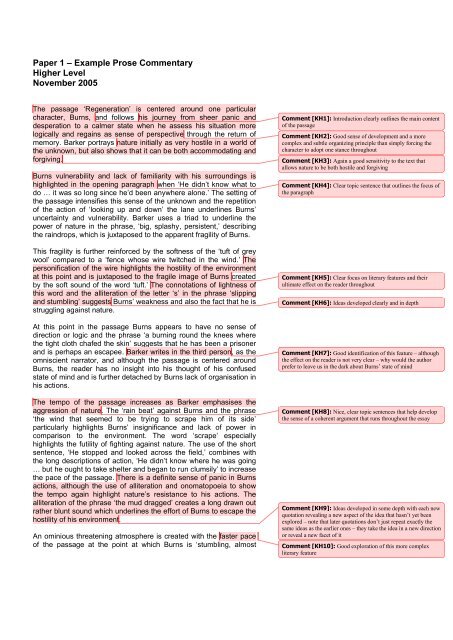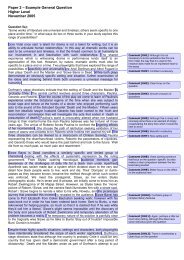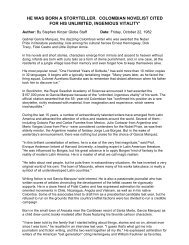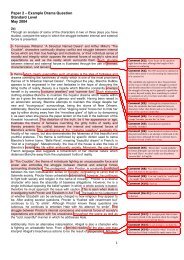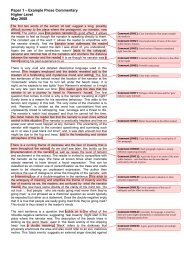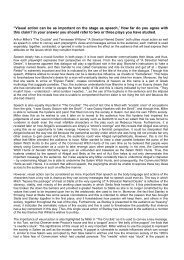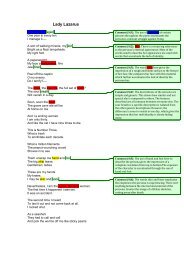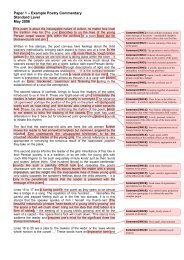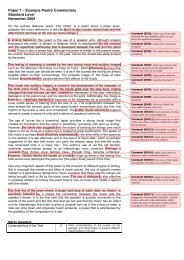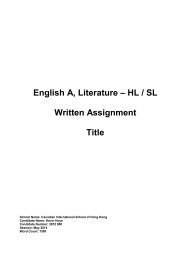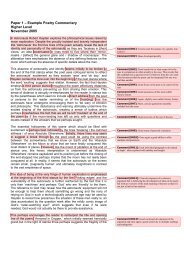Paper 1 â Example Prose Commentary Higher Level November 2005
Paper 1 â Example Prose Commentary Higher Level November 2005
Paper 1 â Example Prose Commentary Higher Level November 2005
You also want an ePaper? Increase the reach of your titles
YUMPU automatically turns print PDFs into web optimized ePapers that Google loves.
<strong>Paper</strong> 1 – <strong>Example</strong> <strong>Prose</strong> <strong>Commentary</strong><strong>Higher</strong> <strong>Level</strong><strong>November</strong> <strong>2005</strong>The passage ‘Regeneration’ is centered around one particularcharacter, Burns, and follows his journey from sheer panic anddesperation to a calmer state when he assess his situation morelogically and regains as sense of perspective through the return ofmemory. Barker portrays nature initially as very hostile in a world ofthe unknown, but also shows that it can be both accommodating andforgiving.Burns vulnerability and lack of familiarity with his surroundings ishighlighted in the opening paragraph when ‘He didn’t know what todo … it was so long since he’d been anywhere alone.’ The setting ofthe passage intensifies this sense of the unknown and the repetitionof the action of ‘looking up and down’ the lane underlines Burns’uncertainty and vulnerability. Barker uses a triad to underline thepower of nature in the phrase, ‘big, splashy, persistent,’ describingthe raindrops, which is juxtaposed to the apparent fragility of Burns.This fragility is further reinforced by the softness of the ‘tuft of greywool’ compared to a ‘fence whose wire twitched in the wind.’ Thepersonification of the wire highlights the hostility of the environmentat this point and is juxtaposed to the fragile image of Burns createdby the soft sound of the word ‘tuft.’ The connotations of lightness ofthis word and the alliteration of the letter ‘s’ in the phrase ‘slippingand stumbling’ suggests Burns’ weakness and also the fact that he isstruggling against nature.At this point in the passage Burns appears to have no sense ofdirection or logic and the phrase ‘a burning round the knees wherethe tight cloth chafed the skin’ suggests that he has been a prisonerand is perhaps an escapee. Barker writes in the third person, as theomniscient narrator, and although the passage is centered aroundBurns, the reader has no insight into his thought of his confusedstate of mind and is further detached by Burns lack of organisation inhis actions.The tempo of the passage increases as Barker emphasises theaggression of nature. The ‘rain beat’ against Burns and the phrase‘the wind that seemed to be trying to scrape him of its side’particularly highlights Burns’ insignificance and lack of power incomparison to the environment. The word ‘scrape’ especiallyhighlights the futility of fighting against nature. The use of the shortsentence, ‘He stopped and looked across the field,’ combines withthe long descriptions of action, ‘He didn’t know where he was going… but he ought to take shelter and began to run clumsily’ to increasethe pace of the passage. There is a definite sense of panic in Burnsactions, although the use of alliteration and onomatopoeia to showthe tempo again highlight nature’s resistance to his actions. Thealliteration of the phrase ‘the mud dragged’ creates a long drawn outrather blunt sound which underlines the effort of Burns to escape thehostility of his environment.An ominious threatening atmosphere is created with the faster paceof the passage at the point at which Burns is ‘stumbling, almostComment [KH1]: Introduction clearly outlines the main contentof the passageComment [KH2]: Good sense of development and a morecomplex and subtle organizing principle than simply forcing thecharacter to adopt one stance throughoutComment [KH3]: Again a good sensitivity to the text thatallows nature to be both hostile and forgivingComment [KH4]: Clear topic sentence that outlines the focus ofthe paragraphComment [KH5]: Clear focus on literary features and theirultimate effect on the reader throughoutComment [KH6]: Ideas developed clearly and in depthComment [KH7]: Good identification of this feature – althoughthe effect on the reader is not very clear – why would the authorprefer to leave us in the dark about Burns’ state of mindComment [KH8]: Nice, clear topic sentences that help developthe sense of a coherent argument that runs throughout the essayComment [KH9]: Ideas developed in some depth with each newquotation revealing a new aspect of the idea that hasn’t yet beenexplored – note that later quotations don’t just repeat exactly thesame ideas as the earlier ones – they take the idea in a new directionor reveal a new facet of itComment [KH10]: Good exploration of this more complexliterary feature
lindly,’ which creates a heightened sense of panic. The defensiveactions of Burns at this point as ‘he snatched’ back his fingers from‘the slime’ also increases the sense of the unknown and theanticipation of the reader. Barker centers the action of the passagearound the image of ‘the tree … laden with dead animals’ by buildingup to a crescendo for the revelation of this image. The phrase‘something brushed against his cheek’ heightens the anticipation forthis revelation, but the panic of Burns prevents him from discoveringthe tree calmly in a composed and logical manner.Barker manipulates the reader’s response to the confronting imageboth through language and Burn’s reaction to the tree. The repulsivesimile ‘bore them like fruit’ juxtaposes the connotations of growth andlife associated with fruit with the rather harrowing description of the‘dead animals.’ The fox ‘its lips curled back from bloodied teeth’ atthis point elicits not sympathy from the reader, but revulsion: feardominates the reaction of Burns to the tree and again the use ofalliteration and personification in the phrase ‘twigs tore at him’highlights his panic. However, it is not the power of nature, but theabuse and destruction of nature that confronts both Burns and thereader.The introduction of the ominous and threatening character of Riversis the turning point of the passage which marks the overcoming ofsheer panic by Burns. There is a sense of danger in the fact thatBurns ‘heard River’s voice as ‘distinctly as he sometimes heard it inhis dreams,’ suggesting that Rivers is a haunting figure of fear forBurns. However, the return of memory and some sense of familiarityfor Burns highlights a change in his state of mind and in hisperception of nature. The word ‘calmer’ conveys this familiarity andthe beginning of a logical assessment of the situation. Barkeremphasises the courage of Burns in his determination and insistencethat ‘the voice was only a voice in his head.’ The overcoming ofpanic is reinforced in the passage by an easing of the tensionpreviously created by the desperation in Burns’ desire ‘to run’ fromthe dead animals.The maltreatment of the animals that were ‘not nailed to [the tree] buttied by wings or paws’ is emphasised b the fact that Burns ‘had seentrees like this before.’ Barker suggests Burns’ tenderness as he‘releases a magpie’ because ‘his teeth ‘were ‘chattering’ as a wingcame away in his hand, showing a repulsion not towards the animal,but towards the cause of its suffering. Barker, at the end of thepassage, portrays also nature’s vulnerability and fragility., becausethe animals are shown as a part of nature. It is the final paragraph ofthe passage that encapsulates the softening of nature and itsvulnerability to abuse by man, as well as its capacity to destroy. Thethreat that surrounds the character of Rivers suggest that he is linkedto the ‘corpses’ of the animals and perhaps inflicted this cruelty onthem. The calculated action of tying the animals ‘by wings or paws ortails’ and leaving them in ‘various stages of decay’ is almost sadistic.However, the ambivalence of the character of Rivers makes itunclear of his culpability for the tree, although it does not detractfrom the cruelty and thus the vulnerability of nature.Burns, who even with the ‘roughness of the bark against his ‘knobblyspine’ seems much calmer and more comfortable at this point in thepassage in the presence of the animals’ corpses is able to work withnature through the cruelty. The phrase ‘the circle of his companions’Comment [KH11]: Continual focus on the effect on the readerComment [KH12]: Good awareness that the whole of thecharacter and his reaction to the tree is being used as a literaryfeature to create an effect on the audienceComment [KH13]: Good ability to identify the key idea hereComment [KH14]: Good sensitivity to shifts in tone or moodComment [KH15]: Good interpolation of ideas from subtlehints in the textComment [KH16]: A good development of this idea whichnicely contrasts with the vulnerability of Burns at the start of thepassageComment [KH17]: Good awareness of the ambiguity orambivalence in the text
suggests the extent of the comfort that they provide Burns andshows that nature can also be accommodating and forgiving.The final line of the passage reflects the cyclical nature of life andnatural processes and makes a reference to the title of the extract‘Regeneration.’ Despite the cruelty that they have endured theanimals can now dissolve into the earth as they were meant to do.’Burns seems much clearer on this point than with regards to hissurroundings at the beginning of the passage, which highlights isjourney from sheer panic to a calmer and more reflective state ofmind. This line also alludes to the ability of nature to recover fromadversity and in doing so highlights that it too can be fragile andvulnerable. The parallels between the tied animsls, representative ofthe more fragile elements of nature, and Burns further underlines theimportance of Barker’s suggestion of working in harmony with naturerather than fighting it.Comment [KH18]: Clear ending that does not simply sum upthe previous ideas but draws the analysis to a closeMarks Awarded:Understanding of the Text 4 Clear understanding of the events ofthe passage and some ability toexplore the ambiguities andambivalences of the passage. Themajority of the text is covered.Interpretation of the Extract 4 Convincing interpretation that is nicelydrawn together into a coherentprogression of ideasAppreciation of LiteraryFeatures4 Literary features are generally wellused, although some of the morecomplex features such as narrativestance or structure, etc, could bemore effectively usedPresentation 5 Overall the essay is very wellstructured with a clear development ofindividual ideas and a sense of overallprogression as we move from oneidea to the nextLanguage 4 Good clear language at points,although there is an absence of anyreally sophisticated vocabulary21 <strong>Level</strong> 7


